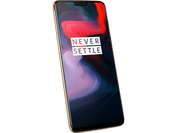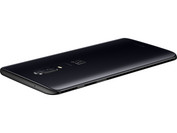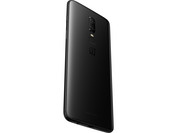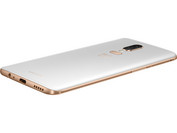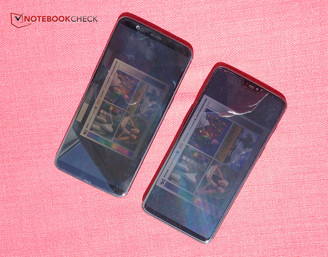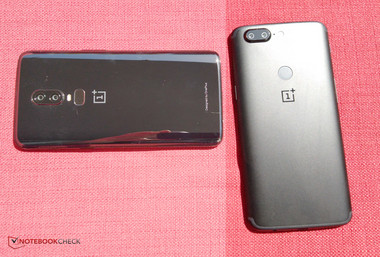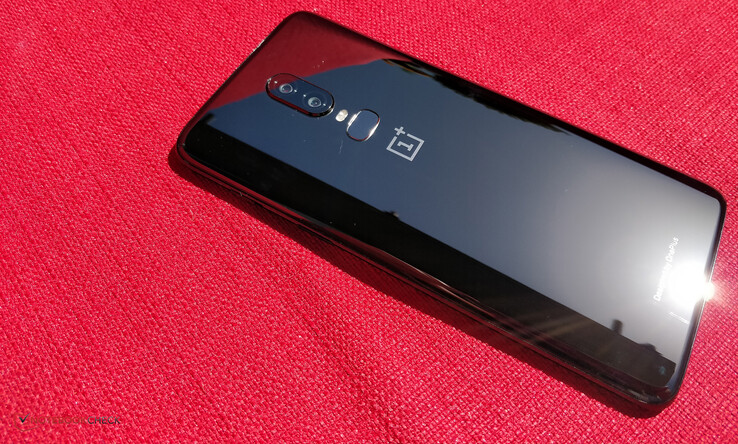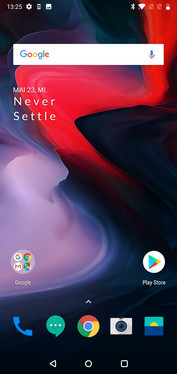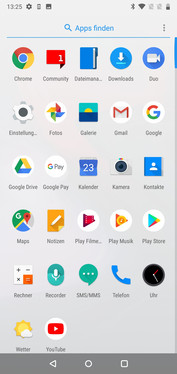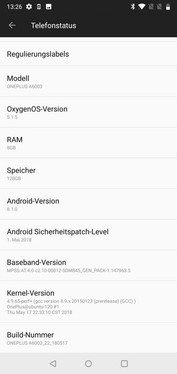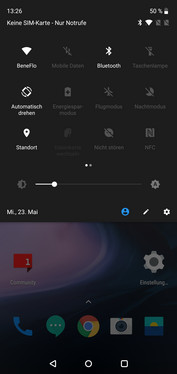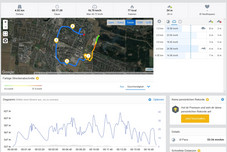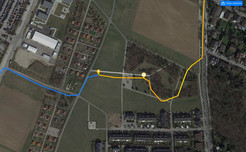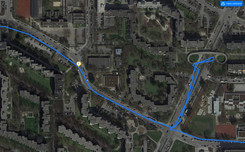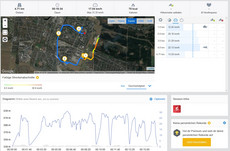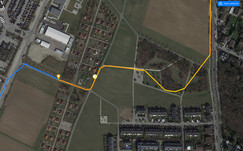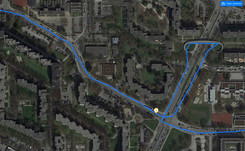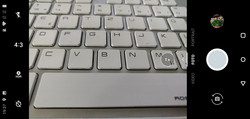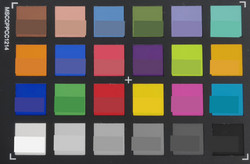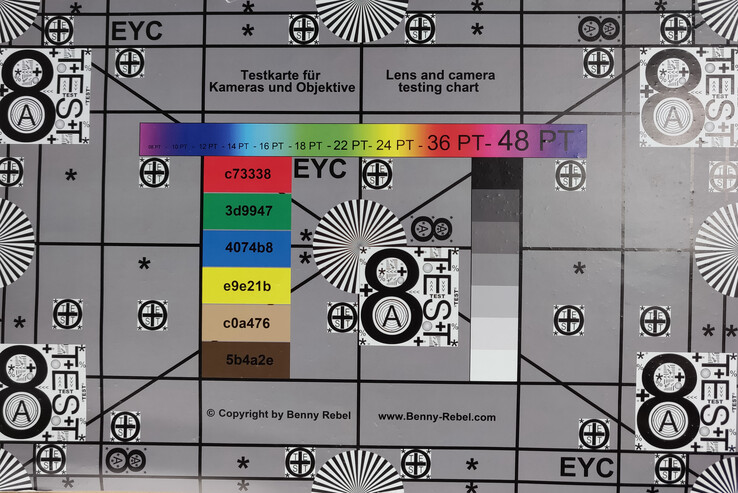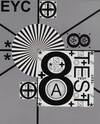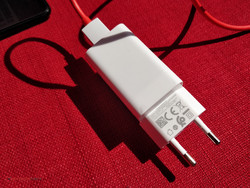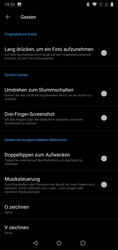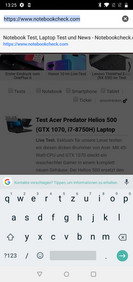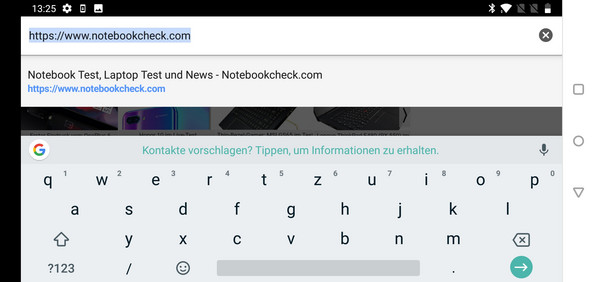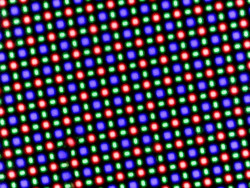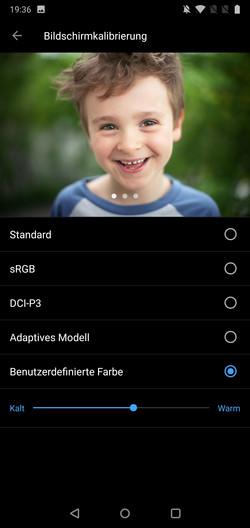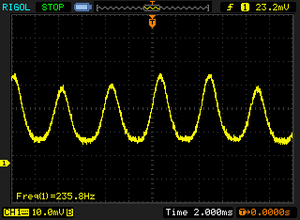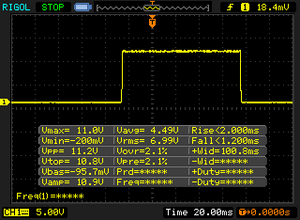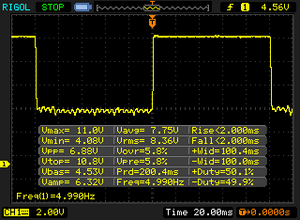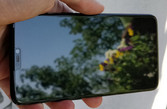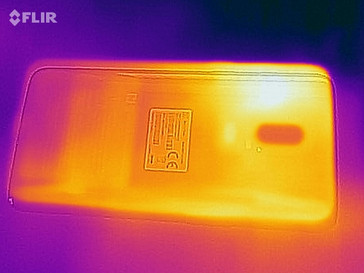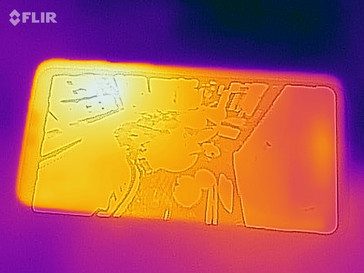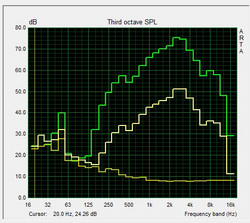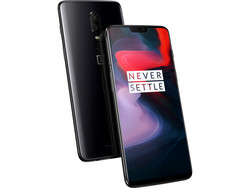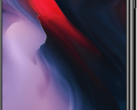OnePlus 6 Smartphone Review
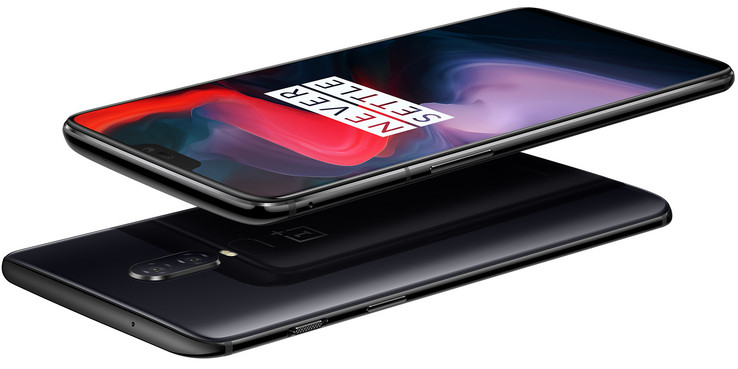
The OnePlus 6 is the latest offshoot of the Chinese Corporation that is a subsidiary of BBK Electronics, which the smartphone brands Oppo and Vivo also belong to. The changes compared to its predecessor are already apparent from the exterior, since both the front and the back of the flagship phone are made of glass.
The OnePlus cell phone is powered by Qualcomm's fastest SoC. The Snapdragon 845 offers a lot of performance, as we have already examined in detail in the Sony Xperia XZ2, among others. In addition, it comes with 6 or 8 GB of RAM depending on the configuration, and buyers can choose between 64, 128 or 256 GB of internal storage. The entry-level model is still relatively cheap at 519 Euros (~$605) and at 619 Euros (~$722), even the largest configuration is still significantly cheaper than most of its competitors on release. However, the price will stay the same throughout the entire sales cycle. For the first time, OnePlus also distributes the smartphone directly through Amazon.
We were glad to see that OnePlus has kept the audio jack for their latest generation phones. The display has slightly grown in size, but the measurements of the case are almost unchanged compared to the OnePlus 5T. However, the notch is new. The manufacturer has also supposedly improved the dual-camera, and the specifications sound promising. The image sensor's size has increased by 19 percent; it is fitted with a nominally strong f/1.7 aperture and once again comes with optical image stabilization. Additionally, the OnePlus 6 is one of the few smartphones able to capture Ultra HD video at 60 frames per second. The Slow-Motion mode offers HD resolution at 480 FPS.
The competition of the self-proclaimed flagship killer consists of everything of distinction. In the review, it will have to hold its own in comparison to the Huawei P20 Pro, Galaxy S9+, LG V30, Apple iPhone X, Google Pixel 2 XL, Sony Xperia XZ2, HTC U11 Plus, Xiaomi Mi Mix 2s and the Razer Phone. The Honor 10 has become an even stronger competitor in terms of price.
Update 8/4/18: OnePlus has released a new update. Details can be found in the software section.
Case – OnePlus 6 with glass surfaces and very sturdy case
While the predecessor, the OnePlus 5T, still had small bezels above and below the display, with the OnePlus 6, the manufacturer relies on a display which occupies almost the entire front. However, in the middle, on the front there is the controversial notch, a black area accommodating the ear speaker, front camera and sensors. Standard notification symbols are displayed to the left and to the right of it. The upper area around the notch can be hidden completely if desired, albeit at a cost to the available display area. A very small chin remains below the screen. CEO Carl Pei has defended the notch in the run-up to the release with the argument that 90% display area on the front would not be possible otherwise.
OnePlus departs from the aluminum unibody of the predecessor for this generation and now uses glass surfaces. A common argument from manufacturers is that it allows for improvements in terms of antenna reception strength and due to the current demand for transfer speeds, metal could not be used for the back at all anymore. The new case with its glass back is available in three color variants: Glossy black, matte black and within the next couple of weeks a white version with golden highlights is supposed to be released as well.
As with the predecessor, the manufacturer has retained the simple elegance with the OnePlus 6: Our test device in Mirror Black looks very sleek with its shiny back that is curved at the edges, but still remains fairly subtle. The HTC U12 Plus with its semi-transparent and red color variants attracts much more attention in that regard. It remains to be seen what OnePlus will present in the coming months.
The smartphone rests in the hand comfortably and transitions between the materials can hardly be felt at all. All in all, the OnePlus 6 comes across as a very high-quality device that, at 177 grams (~6.2 oz), achieves a good balance between light-weight and worth. The case is utterly robust and yields to neither pressure nor twisting. While the OnePlus 6 lacks any kind of IP certification, it is protected against splashing and being submerged in water for a short amount of time thanks to waterproofing and special materials. However, OnePlus explicitly advises against underwater usage.
The OnePlus 6 fared fairly well in first torture tests.
Features - OnePlus 6 only supports USB 2.0
Not much has changed in terms of features for the OnePlus 6. While the USB port possesses the newer Type-C connector style and can be used to connect external input devices or storage media (OTG), it continues to be limited to transfer speeds as per the USB 2.0 standard. Similarly, the interface does not support video output.
There are models with 6 GB of RAM and 64 GB of internal storage, 8 GB/128 GB or 8 GB/256 GB. This wide range of memory configuration options at the very least puts the OnePlus 6 at eye level with its high-end competition, even if not every color variant is available with every memory configuration.
However, even the latest 6 does not offer expandable storage through a microSD card. An FM radio tuner and an infrared blaster are absent as well. In turn, it has fast gigabit LTE with a broad frequency coverage and dual-SIM, ac-WiFi with MIMO antenna technology, NFC as well as up-to-date Bluetooth 5.0.
Software – Close to stock Android and with the latest security patches
OnePlus has installed Android 8.1 on the smartphone, at the date of testing; the security patches are from May 1st 2018 and thus very recent. In the past, the manufacturer had always been known for their rather fast updates.
Despite the fact that OnePlus has modified the user interface by using their own launcher, the difference to stock Android is minimal: When swiping right, instead of the standard Google search, users are greeted by a configurable screen with the most recently used contacts and most used apps; widgets can be placed here as well. There is also a system-wide dark theme and a couple of additional settings.
The user interface is pleasantly minimal otherwise and the manufacturer does not install any bloatware either. In our test device, a generous 116 GB of 128 GB can be used as data storage.
Update 8/4/18: OnePlus has released OxygenOS 5.1.9 (342 MB), which is supposed to improve camera quality for both, the main as well as the front-facing selfie camera, which now features a beauty mode. In addition, Google Lens has been integrated in the camera. Communication features have also received some updates. Among others, the phone now supports group MMS and Wi-Fi as well as Bluetooth stability have been improved. VoLTE and VoWifi on Telia Finland are now officially supported, and gesture detection has been optimized. Google’s security patches have been updated and are now as of July 1st, 2018.
Communication and GPS – The OnePlus 6 is once again a world phone
The OnePlus 6 supports 802.11 a/b/g/n/ac and thus all of the current Wi-Fi standards. Overall, the OnePlus 6 has significantly faster transfer speeds when compared to the OnePlus 5T when it comes to receiving data: Here, OnePlus' last smartphone was a full 37% slower. However, in terms of sending data, it performs slightly worse than its predecessor, altogether its performance is close to the average of high-end smartphones. Subjectively, surfing the web with the OnePlus 6 using Wi-Fi feels very fast: Web pages load very quickly, pictures appear with a very small or no delay at all and scrolling feels smooth. Close to the router, full signal strength is available, 10 meters (~33 ft) away and through 3 walls the signal strength drops to between 3/4th and half, but pages still load as quickly as they do in close proximity to the router.
With 25 LTE bands supported, the OnePlus 6 is a real world phone, meaning that connecting to the LTE network should be possible in almost every country on earth. The maximum download speed is 1.000 MBit/s and the maximum upload speed is 150 MBit/s, here the Samsung Galaxy S9+ or the Sony Xperia XZ2, for example, offer even more speed with up to 1.2 GBit/s download. In practice, this difference is negligible since LTE networks in many countries can barely reach transfer speeds of around 30-40 MBit/s in real world scenarios. Even under ideal circumstances, a maximum of 500 MBit/s is possible in Germany using the Vodafone network. We tested the reception using the German E-net in and around the city: Here, 3/4th signal strength is available even indoors, the OnePlus 6 even managed to hit 4G+ at certain points, which is something that the predecessor that we tested at the same place with the same SIM card, was unable to do. The download speed of 23 MBit/s in a quick test is a good result, the OnePlus 5T reaches about the same transfer speed here.
According to Qualcomm, using LTE through both SIM cards at once should be possible, but the data transfer of the SIM card was always interrupted in our test when we made a call.
| Networking | |
| iperf3 transmit AX12 | |
| LG V30 | |
| OnePlus 5T | |
| Sony Xperia XZ2 | |
| OnePlus 6 | |
| Samsung Galaxy S9 Plus | |
| Apple iPhone X | |
| iperf3 receive AX12 | |
| Apple iPhone X | |
| Sony Xperia XZ2 | |
| LG V30 | |
| Samsung Galaxy S9 Plus | |
| OnePlus 6 | |
| OnePlus 5T | |
The GPS module, of course, also supports other satellite networks like GLONASS, Galileo or BeiDou. It is not able to locate us inside of rooms with a concrete ceiling, not even at the window. Outdoors however, it very quickly achieves a good geolocation accuracy of within 5 meters (~16 ft). The device quickly and reliably locates us on Google Maps and the compass very accurately shows our viewing direction.
We take the OnePlus 6 with us on a bike ride and also bring the professional navigation system Garmin Edge 520 along for comparison. Here, the OnePlus 6 shows convincing results and while it does not determine our position perfectly in the area with the pedestrian and bicycle bridge with the round ramp, it does a much better job than the professional device. The OnePlus 6 also describes the way to and from the bridge fairly accurately, while the Garmin nav messes up here, too.
The OnePlus 6 is absolutely recommendable for people who rely on their smartphone for navigation purposes.
Telephony and Call Quality - Does the OnePlus 6 offer VoLTE?
The telephony app is a minimally adjusted variant of Google's standard app that comes with Android. For example, it gives users the option to send a short reply via SMS when they are unavailable or automatically adds the international area code of the user's country in roaming zones. Interesting: The OnePlus 5T had an activatable feature called noise cancellation; the OnePlus 6 lacks this option. We inquired with the manufacturer whether this means that the feature is always on or if it has been scrapped. We will update the review with the answer as soon as we get it. The topics VoLTE and Wi-Fi Calling are somewhat irritating ones with OnePlus, at least for German customers: OnePlus and the carriers both point fingers at each other since it does not work, even though the device should technically support it. Here, we asked OnePlus for an official stance on the issue as well, and we will update the review with the answer as soon as possible.
The Call Quality of the smartphone is good: The integrated earphone reproduces the voice of the conversational partner quite clearly; at maximum volume, minimal booming can be heard at most. There is some quiet static in the background at maximum volume, but that is just nit-picking to the extreme. Our voice is transmitted clearly and precisely as well, even very loud voices do not cause booming and quiet voices can be heard well, too. The conversational partner can be heard very intelligibly through the speaker phone, the cell phone is also fairly loud. When we speak very quietly ourselves, the microphone only captures parts of what was said, but as long as you talk somewhat clearly, the speech transmission is very good here as well.
Cameras - With a larger sensor and OIS against darkness
Not all that much has changed compared to the predecessor OnePlus 5T. The front camera is technologically identical, has a resolution of 16 MP and once again relies on the Sony IMX 371 image sensor. The lens only has a fixed-focus, but it is equipped with an electronic image stabilizer (EIS). Additionally, it supports HDR and has a Beauty mode and a full-featured portrait mode. The quality of the images is decent, although a lack of sharpness can be seen when fully zoomed in.
The dual-camera on the back has been refined slightly. The resolution stays unchanged at 16 and 20 megapixels respectively. While the secondary, higher resolution optics remains unchanged, the main camera has been upgraded with a new Sony IMX 519 sensor that is about 19 percent larger than the IMX 398. The nominal aperture of f/1.7 is once again rather large and the pixel size climbs to 1.22 µm. The latter is supposed to lead to slightly better pictures in low-light situations, but it does not manage to match the raw technical specifications of the Galaxy S9+ or the Huawei P20 Pro. The 16 MP lens is now backed up by an optical image stabilizer (OIS), which not only improves pictures in low-light scenarios, but also video recordings taken while moving. The image quality is good. In daylight, there are barely any differences compared to the predecessor. While the OnePlus 6 captures the environment slightly better than the iPhone X, the Apple smartphone is more convincing and able to outclass the OnePlus 6 in close shots. In the dark, improvements over the 5T can be observed as well, but they are not able to match the quality of the iPhone X.
The OnePlus 6 is now capable of recording Ultra HD video (3,840x2,160 pixels, 16:9) at up to 60 frames per second, but this feature is limited to 5 minutes. If 30 FPS are sufficient, the maximum possible recording time becomes twice as long. The manufacturer also actively advertises the slow-motion feature. Although its capabilities fall far behind those of the competition. Full HD video can be recorded at up to 240 FPS and the smaller HD format at up to 480 FPS, whereas the Galaxy S9+ offers 960 FPS HD video and the Xperia XZ2 even 960 FPS Full HD video. Furthermore, the slow-motion feature of the OnePlus 6 is limited to one minute, which yields a six minute video.
The image quality of the video recordings is good as well. The OIS steadies the image during faster panning and on the go. We also liked the audio, which is captured in stereo. However, the microphone is very sensitive to wind.
We also took a look the optics' performance under controlled lighting conditions. The color representation on the ColorChecker Passport is mostly strongly saturated, with only the greens appearing a little pale and the whites faintly gray.
We like the depiction of the test chart. The sharpness in the center of the picture is high and just a couple of small details cannot be captured. Neither the color transitions nor dark text on a dark background are a problem for the OnePlus 6. Sharpness decreases towards the edges, but not by an extraordinary amount.
Accessories and Warranty - Lots of accessories for the OnePlus 6, both included and in Accessories Shop
Aside from the quick charge device, which has a nominal output of 20 watts (5 volts, 4 amperes), OnePlus includes a sleek red-white charging cable, a SIM tool, a protective shell and the usual manuals and informational documents. A screen protector that is hard to remove has also been applied to the display. It creates some frictional resistance when dragging the finger over the screen, but does not otherwise impact the handling of the phone. From a design perspective, the screen protector looks fairly subtle except for around the notch.
The OnePlus accessories shop is well-stocked as usual, although the accessories are not exactly cheap: A new fast charge power adapter costs 33 or 38 Euros (~$38 or ~$44), since you can choose the length of the USB cable. The charger costs 20 Euros (~$23) without a cable. Flipcases, protective shells and covers are available for 22 - 32 Euros (~$26 - ~$37), and the popular bumper cases are once again available in real wood, Kevlar fiber or the new nylon variant.
The OnePlus Bullets Wireless are wireless headphones, although they do not get by entirely without cables: They are connected to a small battery, which hangs around the neck. Their backs are magnetic and deactivate the speakers as soon as they snap together. The headphones are water-repellent and can be used through the smartphone's Google Assistant, allowing you to directly access its commands. The battery charges particularly fast, and is supposed to last for 5 hours after 10 minutes of charging. The Bullets Wireless will be available in the near future and they are supposed to cost just under 70 Euros (~$82).
OnePlus gives 24 months warranty, in addition there is the vendor warranty, should you choose not to purchase the smartphone from OnePlus directly. Please see our Guarantees, Return policies and Warranties FAQ for country-specific information.
Input Devices & Handling – Many gestures and a hardware slider
OnePlus uses Google's GBoard as the default keyboard app, which makes for reliable typing on the large display. The smartphone reacts very quickly to inputs.
The Android menu buttons are software buttons, their position can be swapped from the menu and various actions can be mapped to pressing a symbol for a little longer or pressing it twice, for example turning off the display or enabling voice search.
A facial recognition is situated next to the fingerprint sensor on the back that is easy to find thanks to the slight indentation it sits in and is able to unlock the phone from standby quickly and reliably. The former, of course, does not work as well as that of Apple's iPhone X, but at least it no longer gets fooled by a simple picture on the display of a phone. The smartphone first has to be unlocked to activate the facial recognition capabilities, which means that the camera is not permanently active, which should make people with privacy concerns happy. The facial recognition method is more reliable than using the fingerprint sensor, at least in our experience with the OnePlus 6, and all in all it is still less secure. Furthermore, it takes slightly longer for the smartphone to unlock, especially since you have to press the standby button beforehand, while the fingerprint sensor unlocks the smartphone directly.
The touchscreen's handling is great despite the applied screen protector, it reacts extremely quickly and without delay and is very sensitive all the way to the edges.
OnePlus facilitates the use of numerous gestures that can be used to navigate the device: The screen can be activated by double tapping it, if the smartphone is laid down on its screen, it mutes itself or the fingerprint sensor can be used to take pictures.
The smartphone can be set to vibrate or completely silent through a hardware slider on the right side of the case. As with the standby and volume hardware buttons, it feels very high-quality and great to use.
Display - Optical-OLED with a notch
The display of the OnePlus 6 has grown to a sizeable 6.28 inches and has an aspect ratio of 19:9. As with the iPhone X, a notch can be found at the top of the panel. The resolution has been expanded slightly and now totals 2,280x1,080 pixels, which amounts to a high pixel density of 402 PPI, making it exactly the same as the OnePlus 5T's. Other manufacturers such as Samsung or LG equip their flagship smartphones with even higher resolution displays. The manufacturer once again utilizes OLED as the screen's display technology, which creates brilliant black values and an amazing contrast ratio.
In our preview, we assumed that the measured values of the new phone would be on a similar level as those of its predecessor. This would be a meager result, especially in direct sunlight, since we were unable to detect an increase in luminance with an activated light sensor on the OnePlus 5T. This is something we did observe on the P20 Pro and the iPhone. As it happens, this matches up with test results of the OnePlus 6: The light sensor does not cause an increase in display brightness. The display's brightness is about the same as the predecessor's, the OnePlus 6 only reaches a moderate 437 cd/m², whereas the Sony Xperia XZ2 and the Apple iPhone X shine with even brighter displays. The illumination of 87% is a little less than that of most devices in the comparison, but still sufficient for relatively homogeneous color fields.
As with the OnePlus 5T and the Samsung Galaxy S9+ we observed low frequency flickering at 236 Hz across almost every level of brightness. It is used to reduce the brightness of OLED displays for the human eye, but can cause headaches for sensitive people. The response time of the display is rather low and should even satisfy gamers.
| |||||||||||||||||||||||||
Brightness Distribution: 87 %
Center on Battery: 430 cd/m²
Contrast: ∞:1 (Black: 0 cd/m²)
ΔE ColorChecker Calman: 2.3 | ∀{0.5-29.43 Ø4.78}
ΔE Greyscale Calman: 2.4 | ∀{0.09-98 Ø5}
97.4% sRGB (Calman 2D)
Gamma: 2.28
CCT: 6160 K
| OnePlus 6 Optic AMOLED, 2280x1080, 6.3" | Sony Xperia XZ2 IPS, 2160x1080, 5.7" | Samsung Galaxy S9 Plus Super AMOLED, 2960x1440, 6.2" | LG V30 OLED, 2880x1440, 6" | Apple iPhone X Super AMOLED, 2436x1125, 5.8" | OnePlus 5T AMOLED, 2160x1080, 6" | |
|---|---|---|---|---|---|---|
| Screen | 26% | 15% | -48% | 34% | 6% | |
| Brightness middle (cd/m²) | 430 | 630 47% | 565 31% | 432 0% | 600 40% | 425 -1% |
| Brightness (cd/m²) | 437 | 632 45% | 571 31% | 428 -2% | 606 39% | 423 -3% |
| Brightness Distribution (%) | 87 | 96 10% | 96 10% | 87 0% | 94 8% | 92 6% |
| Black Level * (cd/m²) | 0.44 | |||||
| Colorchecker dE 2000 * | 2.3 | 1.5 35% | 2.3 -0% | 4.18 -82% | 1.2 48% | 2.1 9% |
| Colorchecker dE 2000 max. * | 4.6 | 4.3 7% | 4.8 -4% | 8.53 -85% | 3 35% | 3.4 26% |
| Greyscale dE 2000 * | 2.4 | 2.1 12% | 1.9 21% | 5.3 -121% | 1.6 33% | 2.5 -4% |
| Gamma | 2.28 96% | 2.17 101% | 2.16 102% | 2.33 94% | 2.23 99% | 2.32 95% |
| CCT | 6160 106% | 6513 100% | 6332 103% | 7487 87% | 6707 97% | 6455 101% |
| Contrast (:1) | 1432 |
* ... smaller is better
Screen Flickering / PWM (Pulse-Width Modulation)
| Screen flickering / PWM detected | 236 Hz | ||
The display backlight flickers at 236 Hz (worst case, e.g., utilizing PWM) . The frequency of 236 Hz is relatively low, so sensitive users will likely notice flickering and experience eyestrain at the stated brightness setting and below. In comparison: 53 % of all tested devices do not use PWM to dim the display. If PWM was detected, an average of 8111 (minimum: 5 - maximum: 343500) Hz was measured. | |||
We took a closer look at the color accuracy of the OnePlus 6's OLED panel with the help of a spectrophotometer and the CalMAN analysis software. Hereby, we focused on the DCI-P3 and the sRGB color space profiles.
The OnePlus 6 achieved decent results, even though most high-end competitors have a higher color accuracy. The color deviations are slightly higher when using the DCI-P3 mode and can definitely be seen with the naked eye. The depiction of skin colors and blues is slightly too bright. The Color balance is a little too warm. The color representation is better when using the smaller sRGB color space and the color deviations become few and far between, the color balance stays somewhat warm though, which can be adjusted to your liking in the settings. The OLED display looks very nice in day-to-day use.
Display Response Times
| ↔ Response Time Black to White | ||
|---|---|---|
| 3.2 ms ... rise ↗ and fall ↘ combined | ↗ ms rise | |
| ↘ ms fall | ||
| The screen shows very fast response rates in our tests and should be very well suited for fast-paced gaming. In comparison, all tested devices range from 0.1 (minimum) to 240 (maximum) ms. » 13 % of all devices are better. This means that the measured response time is better than the average of all tested devices (20.2 ms). | ||
| ↔ Response Time 50% Grey to 80% Grey | ||
| 4 ms ... rise ↗ and fall ↘ combined | ↗ ms rise | |
| ↘ ms fall | ||
| The screen shows very fast response rates in our tests and should be very well suited for fast-paced gaming. In comparison, all tested devices range from 0.165 (minimum) to 636 (maximum) ms. » 14 % of all devices are better. This means that the measured response time is better than the average of all tested devices (31.6 ms). | ||
While the OnePlus 6 opposes sunlight with an enormous contrast ratio, it still lacks luminance particularly on bright days. Unfortunately, the OnePlus phone has no automatic luminance increase such as the Galaxy S9+ or the P20 Pro. Add to this a reflective surface which hinders the ability to read the display in sunlight and users will find themselves looking for shade quite quickly.
Performance – The OnePlus 6 is a powerful smartphone
The OnePlus 6 uses Qualcomm's fastest SoC to date, the 8 core Snapdragon 845 with a core clock of up to 2,800 MHz. This processor is used in devices like the Xiaomi Mi Mix 2S and the Sony Xperia XZ2 as well. It also makes the OnePlus 6 one of the fastest available smartphones currently available on the market, the jump in performance compared to its predecessor is substantial. Depending on the benchmark, our test device even outperforms the iPhone X. That said, the difference in performance at such a high level are unlikely to be felt, the device feels like it runs very well regardless.
We are particularly like the short system startup time, for example when restarting the device or turning it off over night: The prompt for the PIN code appears after less than 20 seconds, if entered successfully, the fully functional interface is available after 2-3 seconds; the OnePlus 5T starts within a similarly short amount of time.
The Adreno 630 is used as the graphics unit. Not only does it support OpenGL ES 3.2 but also DirectX 12 and is thus future proof in terms of gaming for the next couple of years. The OnePlus 6 easily crushes Samsung Galaxy S9 Plus when it comes to modern games, the two achieve more similar results in older games, at least according to benchmarks. It also outperforms its predecessor in every single benchmark with an advantage of between 20 and 30%.
| AnTuTu v6 - Total Score (sort by value) | |
| OnePlus 6 | |
| Sony Xperia XZ2 | |
| Samsung Galaxy S9 Plus | |
| LG V30 | |
| Apple iPhone X | |
| OnePlus 5T | |
| Average Qualcomm Snapdragon 845 (162183 - 242953, n=23) | |
| AnTuTu v7 - Total Score (sort by value) | |
| OnePlus 6 | |
| Sony Xperia XZ2 | |
| Samsung Galaxy S9 Plus | |
| Apple iPhone X | |
| OnePlus 5T | |
| Average Qualcomm Snapdragon 845 (246366 - 299878, n=27) | |
| PCMark for Android | |
| Work performance score (sort by value) | |
| OnePlus 6 | |
| Sony Xperia XZ2 | |
| Samsung Galaxy S9 Plus | |
| LG V30 | |
| OnePlus 5T | |
| Average Qualcomm Snapdragon 845 (7998 - 13211, n=26) | |
| Work 2.0 performance score (sort by value) | |
| OnePlus 6 | |
| Sony Xperia XZ2 | |
| Samsung Galaxy S9 Plus | |
| LG V30 | |
| OnePlus 5T | |
| Average Qualcomm Snapdragon 845 (7360 - 9868, n=27) | |
| GFXBench 3.1 | |
| on screen Manhattan ES 3.1 Onscreen (sort by value) | |
| OnePlus 6 | |
| Sony Xperia XZ2 | |
| Samsung Galaxy S9 Plus | |
| LG V30 | |
| Apple iPhone X | |
| OnePlus 5T | |
| Average Qualcomm Snapdragon 845 (21 - 59, n=27) | |
| Average of class Smartphone (11 - 166, n=158, last 2 years) | |
| 1920x1080 Manhattan ES 3.1 Offscreen (sort by value) | |
| OnePlus 6 | |
| Sony Xperia XZ2 | |
| Samsung Galaxy S9 Plus | |
| LG V30 | |
| Apple iPhone X | |
| OnePlus 5T | |
| Average Qualcomm Snapdragon 845 (32 - 61, n=28) | |
| Average of class Smartphone (8.4 - 413, n=158, last 2 years) | |
| Basemark ES 3.1 / Metal - offscreen Overall Score (sort by value) | |
| OnePlus 6 | |
| Samsung Galaxy S9 Plus | |
| Apple iPhone X | |
| Average Qualcomm Snapdragon 845 (1169 - 1201, n=5) | |
| Average of class Smartphone (205 - 7731, n=36, last 2 years) | |
Currently, the OnePlus 6 is one of the fastest smartphones when it comes to browsing the web as well: Web pages and pictures are displayed very quickly, even if not quite as fast and fluidly as on the Sony Xperia XZ2 or the iPhone X. Even if it is just nuance, the two devices are ahead of the OnePlus 6 in benchmarks.
We also loaded up Google's complex HTML 5 game “Interland” on the OnePlus 6. The web page was displayed very quickly and the game ran smooth as silk.
| JetStream 1.1 - Total Score | |
| Apple iPhone X (IOS 11.1.1) | |
| Sony Xperia XZ2 (Chrome 65) | |
| OnePlus 6 (Chrome 66) | |
| Average Qualcomm Snapdragon 845 (22.5 - 90.9, n=25) | |
| Samsung Galaxy S9 Plus (Samsung Browser 7.0) | |
| OnePlus 5T (Chrome 63) | |
| LG V30 (Chrome 62) | |
| Octane V2 - Total Score | |
| Average of class Smartphone (2228 - 121337, n=201, last 2 years) | |
| Apple iPhone X (IOS 11.1.2) | |
| OnePlus 6 (Chrome 66) | |
| Sony Xperia XZ2 (Chrome 65) | |
| Average Qualcomm Snapdragon 845 (3991 - 18275, n=28) | |
| Samsung Galaxy S9 Plus (Samsung Browser 7.0) | |
| OnePlus 5T (Chrome 63) | |
| LG V30 (Chrome 62) | |
| Mozilla Kraken 1.1 - Total | |
| LG V30 (Chrome 62) | |
| OnePlus 5T (Chrome 63) | |
| Average Qualcomm Snapdragon 845 (2154 - 11204, n=28) | |
| OnePlus 6 (Chrome 66) | |
| Sony Xperia XZ2 (Chrome 65) | |
| Samsung Galaxy S9 Plus (Samsung Browser 7.0) | |
| Average of class Smartphone (257 - 28190, n=156, last 2 years) | |
| Apple iPhone X (IOS 11.1.2) | |
| WebXPRT 2015 - Overall | |
| Apple iPhone X (Safari Mobile 11.0) | |
| Sony Xperia XZ2 (Chrome 65) | |
| OnePlus 6 (Chrome 66) | |
| Average Qualcomm Snapdragon 845 (96 - 291, n=23) | |
| OnePlus 5T (Chrome 63) | |
| Samsung Galaxy S9 Plus (Samsung Browser 7.0) | |
| LG V30 (Chrome 62) | |
* ... smaller is better
The OnePlus 6 is equipped with rapid UFS 2.1 storage and its read and write times are similar to those of the predecessor. The Samsung Galaxy S9 Plus's storage is still slightly faster, but the difference is marginal. The LG V30 shows that being much slower is an option too. All things considered, the OnePlus 6 looks great in this discipline and is able to match the storage read and write speeds of more expensive devices.
| OnePlus 6 | Sony Xperia XZ2 | Samsung Galaxy S9 Plus | LG V30 | OnePlus 5T | Average 128 GB UFS 2.1 Flash | Average of class Smartphone | |
|---|---|---|---|---|---|---|---|
| AndroBench 3-5 | -5% | 4% | -27% | -3% | 141% | 643% | |
| Sequential Read 256KB (MB/s) | 726 | 679 -6% | 819 13% | 669 -8% | 699 -4% | 761 ? 5% | 2223 ? 206% |
| Sequential Write 256KB (MB/s) | 201.4 | 198.7 -1% | 204.9 2% | 193.2 -4% | 203.4 1% | 296 ? 47% | 1838 ? 813% |
| Random Read 4KB (MB/s) | 137 | 149.4 9% | 129.7 -5% | 78.2 -43% | 138.1 1% | 154 ? 12% | 295 ? 115% |
| Random Write 4KB (MB/s) | 21.8 | 17 -22% | 22.74 4% | 10.21 -53% | 20 -8% | 130.4 ? 498% | 335 ? 1437% |
| Sequential Read 256KB SDCard (MB/s) | 34.25 ? | 79.2 ? | 62.8 | 76 ? | |||
| Sequential Write 256KB SDCard (MB/s) | 30.12 ? | 67.2 ? | 47.2 | 59.6 ? |
Games – 60 FPS gaming and a dedicated gaming mode
The OnePlus 6 enables 60 FPS gaming without issues in most games. The extreme setting of PUBG Mobile runs at only 60 FPS when selecting minimum details; with maximum details the game only runs at 30 FPS, but it still looks smooth. The other high-end games we tested such as “Arena of Valor” or “Shadow Fight 3” run at a smooth 60 FPS. Simpler games like “Angry Birds 2” are not a problem for the OnePlus 6 either.
The controls are a real joy thanks to the very precise touchscreen: Even the very small menu buttons of PUBG Mobile can be pressed without any problems. The gyroscope works flawlessly.
The OnePlus 6 comes with a dedicated game mode, which can be found in the "advanced" section of the settings. Here, a battery saving mode can be activated to limit the resolution and frame rates of games, calls can be put directly on speaker phone and notifications can be suppressed. Additionally, a network acceleration mode can be activated and the automatic brightness adjustment can be turned off. Apps have to be added manually in order to activate the game mode.
| Arena of Valor | |||
| Settings | Value | ||
| min | 60 fps | ||
| high HD | 60 fps | ||
| Shadow Fight 3 | |||
| Settings | Value | ||
| high | 60 fps | ||
| minimal | 60 fps | ||
| PUBG Mobile | |||
| Settings | Value | ||
| Smooth | 60 fps | ||
| Balanced | 40 fps | ||
| HD | 30 fps | ||
Emissions – Some throttling and a weaker speaker
Temperature
The OnePlus 6 heats up significantly under continuous load, especially at the top of the front, reaching up to 45.3 °C (~113.5 °F). This is very noticeable and can become uncomfortable during the summer, when putting the smartphone in your pocket after prolonged use. The rise in temperature can be barely felt during idle: The maximum of 30.5 °C (~86.9 °F) is a very moderate value.
A slight decrease in performance by a good 10% is unavoidable for the OnePlus 6 when it is under load for a prolonged period of time. We were able to observe this fact in the GFXBench battery test Manhattan 3.1, which repeats the same sequence for 30 cycles and logs the frame rates. However, this dip in performance is far smaller than that of the Samsung Galaxy S9 Plus or the Sony Xperia XZ2.
(-) The maximum temperature on the upper side is 45.3 °C / 114 F, compared to the average of 35.2 °C / 95 F, ranging from 21.9 to 247 °C for the class Smartphone.
(±) The bottom heats up to a maximum of 42.5 °C / 109 F, compared to the average of 34 °C / 93 F
(+) In idle usage, the average temperature for the upper side is 29.8 °C / 86 F, compared to the device average of 32.9 °C / 91 F.
Speakers
The speaker is installed on the left on the bottom edge, as was the case with its predecessor, and is once again a mono speaker. The small speaker tends to sound scratchy at maximum volume, which causes singing in particular to sound somewhat unpleasant. Here, the speaker of the OnePlus 5T sounds far warmer and more well-rounded. Both speakers struggle with classical music, although OnePlus' last smartphone allows for better differentiation between individual instruments than the OnePlus 6. The speaker of our current test device is a bit quieter than the predecessor's as well. In a direct comparison, we much prefer the speaker of the OnePlus 5T, especially at maximum volume.
While we did write in our preview that OnePlus would enable audio output both through USB Type-C and the 3.5 mm audio jack, the output through USB Type-C did not work in our test, neither with a 3.5 mm adapter nor with a USB Type-C headset.
If you wish to connect headphones, you can use the conventional 3.5 mm plug, which creates a hassle-free audio output with good quality. The OnePlus 6 does not have a Hi-Res audio certification, sound effects for headphones can be set through Dirac HD Sound, which also has an equalizer. These settings can be found under "Audio & Vibration".
The OnePlus supports Bluetooth 5.0, which enables faster transfers, a higher range and likely improved audio quality due to an increased packet size. While there are currently few devices that support Bluetooth 5.0, the standard is downward-compatible. Bluetooth pairing works quickly and without any issues, the audio quality is good.
OnePlus 6 audio analysis
(±) | speaker loudness is average but good (81.6 dB)
Bass 100 - 315 Hz
(-) | nearly no bass - on average 62.6% lower than median
(+) | bass is linear (0% delta to prev. frequency)
Mids 400 - 2000 Hz
(-) | nearly no mids - on average 62.6% lower than median
(+) | mids are linear (0% delta to prev. frequency)
Highs 2 - 16 kHz
(-) | nearly no highs - on average 62.6% lower than median
(+) | highs are linear (0% delta to prev. frequency)
Overall 100 - 16.000 Hz
(-) | overall sound is not linear (108.7% difference to median)
Compared to same class
» 87% of all tested devices in this class were better, 0% similar, 13% worse
» The best had a delta of 11%, average was 35%, worst was 134%
Compared to all devices tested
» 96% of all tested devices were better, 0% similar, 4% worse
» The best had a delta of 4%, average was 24%, worst was 134%
OnePlus 5T audio analysis
(+) | speakers can play relatively loud (86.3 dB)
Bass 100 - 315 Hz
(-) | nearly no bass - on average 21.2% lower than median
(±) | linearity of bass is average (9.9% delta to prev. frequency)
Mids 400 - 2000 Hz
(+) | balanced mids - only 3% away from median
(+) | mids are linear (6% delta to prev. frequency)
Highs 2 - 16 kHz
(±) | higher highs - on average 5.9% higher than median
(+) | highs are linear (3.8% delta to prev. frequency)
Overall 100 - 16.000 Hz
(±) | linearity of overall sound is average (18.4% difference to median)
Compared to same class
» 19% of all tested devices in this class were better, 9% similar, 72% worse
» The best had a delta of 11%, average was 35%, worst was 134%
Compared to all devices tested
» 40% of all tested devices were better, 8% similar, 52% worse
» The best had a delta of 4%, average was 24%, worst was 134%
Battery Life – OnePlus 6 with low energy consumption and great battery running times
Energy consumption
Not much has changed in terms of energy consumption compared to the OnePlus 5T, only the OnePlus 6's average energy consumption during idle is significantly lower. On the flipside, average energy consumption of the OnePlus 6 under load is higher than that of the predecessor. The smartphone consumes 8.6 watts at max, which is very close to the 5T.
All in all, the OnePlus 6 is a rather economical smartphone, the only one that is even more economical is the Samsung Galaxy S9 Plus. The energy consumption of the turned off test device or of the test device in standby does not leave anything to be desired either.
| Off / Standby | |
| Idle | |
| Load |
|
Key:
min: | |
| OnePlus 6 3300 mAh | Xiaomi Mi Mix 2S 3400 mAh | Sony Xperia XZ2 3180 mAh | Samsung Galaxy S9 Plus 3500 mAh | Apple iPhone X 2716 mAh | OnePlus 5T 3300 mAh | Average Qualcomm Snapdragon 845 | Average of class Smartphone | |
|---|---|---|---|---|---|---|---|---|
| Power Consumption | -43% | -39% | 11% | -44% | -2% | -33% | -36% | |
| Idle Minimum * (Watt) | 0.6 | 0.75 -25% | 0.72 -20% | 0.68 -13% | 1.03 -72% | 0.58 3% | 0.862 ? -44% | 0.848 ? -41% |
| Idle Average * (Watt) | 1 | 2.25 -125% | 2.21 -121% | 0.95 5% | 2.4 -140% | 1.44 -44% | 1.728 ? -73% | 1.434 ? -43% |
| Idle Maximum * (Watt) | 1.6 | 2.26 -41% | 2.22 -39% | 1.09 32% | 2.6 -63% | 1.53 4% | 2.07 ? -29% | 1.618 ? -1% |
| Load Average * (Watt) | 4.3 | 4.89 -14% | 4.6 -7% | 4.58 -7% | 2.96 31% | 3.17 26% | 4.87 ? -13% | 7.01 ? -63% |
| Load Maximum * (Watt) | 8.6 | 9.6 -12% | 9.34 -9% | 5.16 40% | 6.6 23% | 8.54 1% | 9.27 ? -8% | 11.3 ? -31% |
* ... smaller is better
Battery Life
Even though we have not yet finished all of our battery tests, we can already tell that the OnePlus 6 seems to have inherited the very good running times of its predecessor and even surpasses them by a small margin. The battery capacity is the same as the OnePlus 5T's: It holds up to 3,300 mAh. This is enough for 12:42 hours in the Wi-Fi test, which is the best result of all devices in the comparison. The smartphone even lasts 30 minutes longer while watching movies.
In day-to-day use, you usually barely have to worry about the running time of the OnePlus 6: Even at 20% charge, the battery will last for a day when using the device sparingly. For non-hardcore mobile gamers, charging the smartphone every two to three days is sufficient. OnePlus does not offer additional energy saving modes aside from the default Android energy saving mode and a per-app battery consumption limit.
We are already acquainted with the large, sleekly designed charger from the predecessor. It has a maximum nominal output of 20 watts and still carries the Dash logo, even though this is no longer OnePlus' official name for their quick charge technology, after numerous companies lodged an appeal against a trade mark registration. Currently, the technology is simply called OnePlus quick charge or fast charge and still offers incredibly fast charging speeds: After the battery test, it only took a little over an hour to charge our OnePlus 6 from 0% to 100%, after just 15 minutes yields enough charge to make it through the day with economical usage. The quick charge technology is fantastic for people who often quickly charge their smartphone just before leaving.
| OnePlus 6 3300 mAh | Xiaomi Mi Mix 2S 3400 mAh | Sony Xperia XZ2 3180 mAh | Samsung Galaxy S9 Plus 3500 mAh | OnePlus 5T 3300 mAh | Apple iPhone X 2716 mAh | |
|---|---|---|---|---|---|---|
| Battery runtime | -6% | -19% | -19% | -1% | -26% | |
| Reader / Idle (h) | 30.1 | 28 -7% | 23.4 -22% | 22.4 -26% | 29.2 -3% | 21.5 -29% |
| H.264 (h) | 13.2 | 12 -9% | 12 -9% | 11.2 -15% | 13.3 1% | 10.6 -20% |
| WiFi v1.3 (h) | 12.7 | 11.9 -6% | 11.3 -11% | 8.7 -31% | 12 -6% | 9.4 -26% |
| Load (h) | 4.1 | 4 -2% | 2.7 -34% | 4 -2% | 4.3 5% | 3 -27% |
Pros
Cons
Verdict – The OnePlus 6 is worth a buy
The OnePlus 6 is a very high-quality smartphone, offering high-end features at a great price-performance ratio. However, its lower price is not a coincidence: OnePlus completely disregards the VR topic, which is reflected in the display technology as well, where the FHD+ resolution has to suffice. Generally, there does not seem to be any advancements in terms of the panel, the notch is purely a matter of taste. We would have wished for something similar to Apple's True-Tone display or a 120 Hz panel. The departure from the aluminum unibody follows a trend as well, but does not grant the OnePlus cell phone wireless charging capabilities. Likewise, instead of a faster transfer standard that could offer more features such as video output or a desktop mode, USB 2.0 is relied upon.
OnePlus instead relies on the core competencies of a smartphone and equips its latest smartphone with more speed, storage that is both bigger and faster, up-to-date software and a good camera. However, the advancements compared to the predecessor are marginal as well. Battery life is about the same as the predecessor's, which, despite not being a surprise, is still nice since the OnePlus 5T was a real long-runner already. Additionally, it comes with a lightning-fast quick charge technology, which we already know from the OnePlus 5T, but no longer carries the name Dash Charge (name had to be changed due to licensing conflicts).
OnePlus once again produces an excellent smartphone. Foregoing some high-end gimmicks, the OnePlus 6 does a great job of combining high performance with a low price.
In summary, OnePlus once again delivers a very good smartphone. But the competition in this area is increasing. The Honor 10 with its aggressive price (starting at 399 Euros RRP) in particular is nothing to be scoffed at and the soon to be available Asus ZenFone 5z as well as the Xiaomi Mi Mix 2s play in the same league both in terms of technology and price.
OnePlus 6
- 05/29/2018 v6 (old)
Daniel Schmidt & Florian Wimmer




